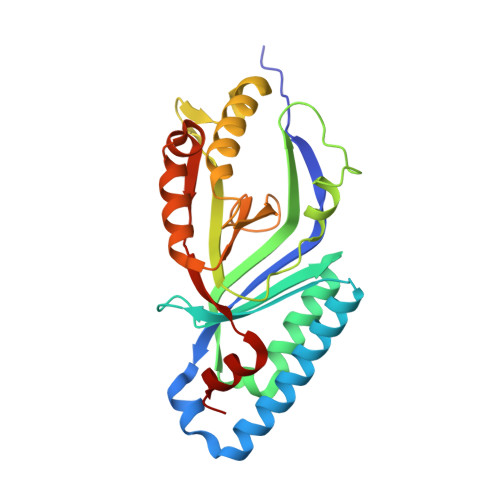Structure-based functional identification of a novel heme-binding protein from Thermus thermophilus HB8.
Ebihara, A., Okamoto, A., Kousumi, Y., Yamamoto, H., Masui, R., Ueyama, N., Yokoyama, S., Kuramitsu, S.(2005) J Struct Funct Genomics 6: 21-32
- PubMed: 15965735
- DOI: https://doi.org/10.1007/s10969-005-1103-x
- Primary Citation of Related Structures:
1VDH - PubMed Abstract:
The TT1485 gene from Thermus thermophilus HB8 encodes a hypothetical protein of unknown function with about 20 sequence homologs of bacterial or archaeal origin. Together they form a family of uncharacterized proteins, the cluster of orthologous group COG3253. Using a combination of amino acid sequence analysis, three-dimensional structural studies and biochemical assays, we identified TT1485 as a novel heme-binding protein. The crystal structure reveals that this protein is a pentamer and each monomer exhibits a beta-barrel fold. TT1485 is structurally similar to muconolactone isomerase, but this provided no functional clues. Amino acid sequence analysis revealed remote homology to a heme enzyme, chlorite dismutase. Strikingly, amino acid residues that are highly conserved in the homologous hypothetical proteins and chlorite dismutase cluster around a deep cavity on the surface of each monomer. Molecular modeling shows that the cavity can accommodate a heme group with a strictly conserved His as a heme ligand. TT1485 reconstituted with iron protoporphyrin IX chloride gave a low chlorite dismutase activity, indicating that TT1485 catalyzes a reaction other than chlorite degradation. The presence of a possible Fe-His-Asp triad in the heme proximal site suggests that TT1485 functions as a novel heme peroxidase to detoxify hydrogen peroxide within the cell.
- RIKEN Harima Institute at SPring-8, Kouto, Mikazuki-cho, Sayo-gun, Hyogo, 679-5148, Japan.
Organizational Affiliation:
















